FOREWORD
I am not an astrologer or astronomer (I am but a musician-composer and sound engineer with a keen interest in this subject). This article is in the first place written for musicians that – like myself – are intriqued by this topic and perhaps for some astrologers it might turn out to be an interesting read as well.
This article is an ongoing “work-in-progress” … and because I am no “expert” in astrology I do welcome additional info, suggestions and corrections (in case of mistakes made in this article). Thank you!
FOOTNOTES:
- The seasons mentioned in this article are as the are at the Northern hemisphere (North of the Equator).
- The exact dates that cover the periods of the Zodiac Signs might differ, that depends on the system used.
- All dates, numbers and frequencies mentioned in this blog article are an approximation.
TOPICS:
THE ZODIAC (INTRODUCTION) | HISTORICAL PERSPECTIVE | PTOLEMY | MARSILIO FICINO | RUDOLF STEINER | MAX HEINDEL | ANNY VON LANGE | SIGISMUND VON GLEICH | MARIUS SCHNEIDER | ALAIN DANIELOU | STOCKHAUSEN | HENSHEL & HENSHEL-FISHER | MCMULLIN | ASPECTS, SIGN-GROUPS, MODES & DEGREES | JOHANNES KEPLER | RUDOLF HAASE | SUMMERY TIMELINE | GEOMETRY & GROUPS | CHROMATIC SCALE, THE PIANO AND MONTHS OF THE YEAR |
THE ZODIAC (INTRODUCTION)
The zodiac is the circle of constellations traversed by the sun, moon and planets in their yearly cycle, as seen from Earth. Traditionally his circle is divided into 12 sections of 30 degrees each, the Zodiac signs. The Zodiac is an ecliptic coordinate system, which takes the ecliptic as the origin of latitude, and the position of the Sun at vernal equinox as the origin of longitude.
Astrologers track the planets as they continue on in the sky after birth, moving through the houses of the natal chart as they progress through the zodiac.
A SHORT HISTORICAL TIME-LINE:
During the early 1st millennium BC the Babylonian astronomers divided the ecliptic into twelve equal zones of celestial longitude to create the first known celestial coordinate system. The Babylonian calendar as it stood in the 7th century BC assigned each month to a sign, beginning with the position of the Sun at vernal equinox, which at the time was depicted as the Aries constellation (“Age of Aries“). This is the reason why the “first sign” in Astrology is still called “Aries“, even after the vernal equinox has moved away from the Aries constellation due to the slow precession of the Earth’s axis of rotation.
Knowledge of the Babylonian zodiac is also reflected in the Tanakh (Jewish Bible), and is the first recorded astrological division into 12 constellations, elaborated on in the Talmuds (= “learning”, a collection of writings named specifically the Babylonian Talmud), Midrash Rabba (books of the Tanakh), and other minor works.
The Babylonian star catalogs entered Greek astronomy in the 4th century BC. Horoscopic astrology first appeared in Ptolemaic Egypt. The Dendera zodiac, a relief dating to ca. 50 BC, is the first known depiction of the classical zodiac of twelve signs.
Particularly important in the development of Western horoscopic astrology was the astrologer and astronomer Ptolemy, whose work Tetrabiblos laid the basis of the Western astrological tradition. Ptolemy explained the theoretical basis of the western zodiac as being a tropical coordinate system, by which the zodiac is aligned to the equinoxes and solstices, rather than the visible constellations that bear the same names as the zodiac signs.
THE ZODIAC SIGNS (SYMBOLS)
Not all visitors of this blog have experience with astrology, therefor first the symbols of and the names of the Zodiac signs they represent used in this article:
 |
|||||||||||
A HISTORICAL PERSPECTIVE
Before we come to the practical implementation it would be good to place this topic in historical perspective. The relationship between tonality and the signs of the Zodiac has been a subject that intrigued and inspired various astronomers, astrologers, philosophers, composers and musicians. After all, there are 12 tones in Western music and there are 12 Zodiac signs, all with their own “characteristics” and “color”.
When it comes to the relationship between western Astrology and western music, you can’t write an article without at least shortly mentioning Pythagoras (a name you might have come across in various other tuning-related articles on my blog) and his theory Musica Universalis (Music Of The Spheres).
PYTHAGORAS (c. 570 – c. 495 BC) – MUSIC OF THE SPHERES
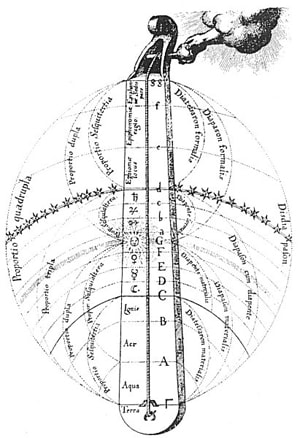
Musica Universalis (literally universal music), also called Music of the Spheres or Harmony of the Spheres, is an ancient philosophical concept that regards proportions in the movements of celestial bodies — the Sun, Moon, and planets — as a form of musica (the Medieval Latin term for music).
This “music” is not usually thought to be literally audible, but a harmonic, mathematical or religious concept. The idea continued to appeal to thinkers about music until the end of the Renaissance, influencing scholars of many kinds, including humanists.
The “Music of the Spheres” incorporates the metaphysical principle that mathematical relationships express qualities or “tones” of energy which manifest in numbers, visual angles, shapes and sounds – all connected within a pattern of proportion.
Pythagoras first identified that the pitch of a musical note is in proportion to the length of the string that produces it, and that intervals between harmonious sound frequencies form simple numerical ratios.
The Pythagoreans were mainly interested in the mathematical aspects of the movements of the stars and less in the “images” of the constellations.
“Sounds are the echo of the “Harmony of the Spheres” which man took into himself when he came down from the divine-spiritual world into the physical world.“
Rudolf Steiner
Fellow blogger Joe Dubs created for his article about Musical Geometry a nice visualization of the planetary relationships (distances according to NASA) as written about in an article of Keplerstern Verlag. A couple of these planetary relationships represent musical ratios. Read this article to learn more about the Semi-Minor Axes Geometry …
Left to right: Mercury, Venus, Earth, Mars, Jupiter, Saturn, Uranus, Neptune, Pluto.

In the image above you see the following musical ratios: 2:1 = Octave, 3:2 = Perfect Fifths and 4:1 = 15th (or 2 Octaves). The other ratios (8:3, 25:1 and 25:4) aren’t common intervals in musical tuning, but for those who enjoy microtonal music those macrocosmic ratios might be worth experimenting with.
Another article by Joe Dubs with nice visualizations on this subject is his article about the orbital patterns of the planets in our solar system reveals other musical ratios such as the tonic (1:1) and perfect fourths (4:3). “The Music of the Spheres – Musica Universalis” (Joe Dubs) might be a nice read for you as well …
It is interesting to note that the most important interval in music, the 5th (the interval Pythagoras based his musical tuning system on), represents the relationship between Earth and Mars. Astrology wasn’t something Pythagoreans were much interested in though, unlike Astronomy … but that aside:
In astrology, Mars is the planet of determination, ambition and competition, energy, action, desire, passion, aggression, anger. Mars, the God of War, is the ruler of Aries. It is the survival instinct, and can be thought of as the “leftover” animal nature of man. Our sexual desires come under the rule of Mars. Mars’s energy can be constructive or destructive. It takes nearly two years for Mars to complete its orbit through the zodiac.
Many great thinkers such asPlato, Nicomachus of Gerasa, Galileo, Martin Mersenne and Athanasius Kirchner continued developing what Pythagoras started.
A different more literal, creative, modern scientific approach to “Music of the Spheres” is the work “Wheel of Stars” by Jim Bumgardner, where Bumgardner relates star position, parallax, magnitude, and color information to sound pitch.
In the more recent history Music of the Spheres has inspired various (contemporary) composers and artists such as: Rued Langaard (“Music of the Spheres“), Mike Oldfield (“Music of the Spheres“), Björk (“Cosmogony“) and others …




Even though there is a lot more to share and write about Music Of The Spheres, I will proceed with “The Tone-Zodiac” (a historical time-line), a topic that has a more direct connection to the practical implementation of Astrology and music.
THE TONE ZODIAC (A HISTORICAL TIME-LINE)
It is only half a millennium after Pythagoras that there is evidence of a “Tone-Zodiac”, in Ptolemy’s writings. At that basis of the connection between music and the Zodiac lies the Pythagorean-Platonic vision of heavenly harmony. The “Tone-Zodiac” is a system that combines a Tone Circle with the Zodiac Circle and is by far the easiest method to visualize the connection between the Zodiac and musical tonalities.
PTOLEMY (c. 100 – c. 168 CE)
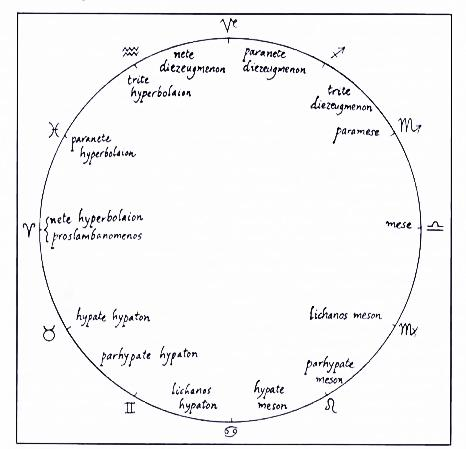
(img. Godwin, 1993: 30)
Ptolemy explains the astrological aspects by invoking music as an analogy, following Pythagorean ideas about the role of the ratios.
He presents his tone-zodiac in chapter 8 of book III of “The Harmonics“, written near the end of his life, around 168 CE.
He lays out a two-octave Pythagorean scale on a zodiac circle, noting that the rotating movements of the stars are all circular and regular and similar to the movements within the tone-system.
In this form of the tone-zodiac, the octave (2:1) comes opposite in the circle, and so cuts it in two (1:2), which he considers ‘a great mystery’. To the modern sense of consonance it seems strange to portray opposition by the octave and conjunction by the double octave.
This Tone-Zodiac has the following Tone-Sign combination:
| A | B | C | x | D | x | E | F | G | A1 | B1 | C1 | x | D1 | x | E1 | F1 | G1 |
This Tone-Zodiac starts at Aries with A and goes around the Zodiac circle counterclockwise (as is common with Astrology).
Ptolemy continues his argument in “The Harmonics” with a comparison of the rising and falling motion of stars with the genera in music. This comparison, based on the tropics, connects the Seven Greek Modes with the twelve star signs (image below: Godwin, 1993, p. 36):
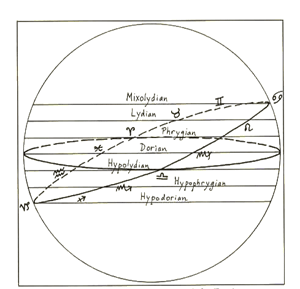
This comparison, based on the tropics, connects the Seven Greek Modes with the twelve star signs:
- Gemini (
 ) & Cancer (
) & Cancer ( ): Mixolydian (B)
): Mixolydian (B) - Taurus (
 ) & Leo (
) & Leo ( ): Lydian (C)
): Lydian (C) - Aries (
 ): Phrygian (D)
): Phrygian (D) - Pisces (
 ) & Virgo (
) & Virgo ( ): Dorian (E)
): Dorian (E) - Aquarius (
 ) & Libra (
) & Libra ( ): Hypolydian (F)
): Hypolydian (F) - Scorpio (
 ): Hypophrygian (G)
): Hypophrygian (G) - Capricorn (
 ) & Sagittarius (
) & Sagittarius ( ): Hypodorian (A)
): Hypodorian (A)
This Tone-Zodiac has the following Tone-Sign combination:
| D | C | B | B | C | E | F | G | A | A | F | E |
The Circle with the Zodiac Signs is drawn clockwise, (instead counterclockwise as is common in Astrology) and starts with Aries at D. The way the Signs are grouped in the image (on what “line” the signs are placed) is not logical. There are several ways to “group” Zodiac signs (traditionally grouped in: Polarities, Triplicities, Quadruplicities) but the “grouping” seen in the picture does not match any. Later in this article more about these groups.
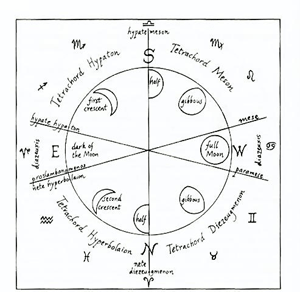
(Godwin, 1993, p. 36)
Ptolemy also presented a tone-zodiac of two octaves showing the course of the moon as well, exemplifying that of all the planets, from its conjunction with the sun at the dark of the moon.
As this chapter survives only in very corrupt manuscripts it is not very useful not go into detailhere (source: Godwin 1993, p. 36, 416). But it does show that the concept of the tone-zodiac, in different forms, was well-known to Ptolemy.
The used musical scale in the image on the left is the same as in the image with the first shared Ptolemy Tone Zodiacs. This Tone-Zodiac has the following Tone-Sign combination:
| E | D | C | B/A | G | F | E | D | C | B/A | C | D |
Above we see the “Perfect Immutable System” (diatonic genus) that combines the “Greater Perfect System” and the “Lesser Perfect System. The “Perfect Immutable System” is divided into 4 “tetrachords“, each diatonic tetrachord consists of two intervals of a tone and one of a semitone.
The “Tetrachord Diezeugmenon” contains the tones E (Nete diezeugmenon at Aries), D, C and B.
The “Tetrachord Meson” contains E (Hypate Meson at Libra), F, G and A.
The “Tetrachord Hypaton” contains the tones E (Hypate Meson at Libra), D, C and B.
The “Tetrachord Hyperbolaion” contain the tones E (Nete diezeugmenon at Aries), D, C and B.
In this Tone Zodiac the Cardinal Directions were added as well. If the Tetrachords were implemented correctly, we find E at both North (Aries) and South (Libra). The East (Capricorn) is “sidelined” by “Hypate Hypaton” (B) and “Proslambanomenos” (A) / “Nete Hyperbolaion” (A), the West (Cancer) is “sidelined” by “Mese” (A) and “Paramese” (B). These “sidelines” connect diametrically to the same tone on the other side of the Tone Zodiac.
The Tone Zodiac starts at Aries with E and goes around counterclockwise (as is common in astrology).
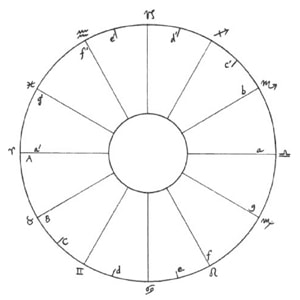
In the Ptolemaic Tone-Zodiac on the left (Godwin, 1993) only the 7 tones of the Diatonic Scale (white key tones on the piano) of A-Minor (A-B-C-D-E-F-G) have been noted, covering two octaves to complete the circle counterclockwise (as is common in Astrology). What is interesting though about this Tone-Zodiac is that not all tones align with the cusps of the signs. In this Tone-Zodiac the C, D, and E are placed in the center of the sign sector. That might “suggests” that we are looking at a 12-Tone Equal Tempered (Chromatic) circle with only some tones high-lighted.
What is interesting though about this Tone-Zodiac is that not all tones align with the cusps of the signs. In this Tone-Zodiac the C, D, and E are placed in the center of the sign sector. That might “suggests” that we are looking at a 12-Tone Equal Tempered (Chromatic) circle with only some tones high-lighted.
Or, perhaps we are looking at a Tone-Zodiac that shows a single scale. When we write the tones only (not the tonalities) that are positioned at the cusps of each sector we get the following scale: A-B-C♯-D♯-F-G, a Hexatonic or Whole-Tone scale of A.
This Tone-Zodiac has the following Tone-Sign combination:
| A/A1 | B | C | x | D | x | E | F | G | A | B | C1 | x | D1 | x | E1 | F1 | G1 |
This Tone-Zodiac starts at Aries with A and goes around the Zodiac circle counterclockwise (as is common with Astrology).
After Ptolemy ancient and medieval scholars in Western Europe discussed the connections between the planetary movements to the musical scale, but not to the zodiac.
In the Italian Renaissance the tone-zodiac surfaces again.
MARSILIO FICINO (1433-1499)
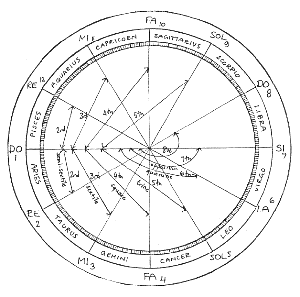
Marsilio Ficino, standing on Ptolemy’s shoulders, adds something new. In his letter to the musician-philosopher Domenico Benivieni he allows for a connection between the astrological houses and the musical intervals on the basis of the astrological aspects (source: Godwin, 1993, p. 168, Voss 2006: 186).
In his tone-zodiac he uses a one-octave scale and places the major seventh as the opposite aspect. However, he manages to keep the Ptolemaic consonances of whole-tone (sextile), fourth (square) and fifth (trine) in the same place (source: J. Godwin 1993, p. 32).
Voss argues that Ficino is advocating in his letter a tuning system in accordance with contemporary practice and the requirements of musicians, and which correlates more exactly with astrological law (source: A. Voss 2006, p. 187). As Ficino was a practising astrologer and a musician himself he may have chosen to adapt the Ptolemaic tone-zodiac to fit his own practice.
This Tone-Zodiac has the following Tone-Sign combination:
| C | D | E | F/A | G | A | B | C | G | F/A | E | D |
If Ficino was using the “Movable-Do” system, this Tone-Zodiac would display the Major scales with “Do” reprecenting the “Tonic” of the scale. If Ficino was using the “Fixed-Do” system, then this Tone-Zodiac would represent the scale of C Major. Ficino follows the circle diatonically (7-tone white note scale) counterclockwise (as is common in Astrology).
In the “Age of Enlightenment” no new tone-zodiacs appear.
The renewed interest in the esoteric wisdom of antiquity in the romantic times of the later nineteenth century reintroduces the idea, which flowers in the Theosophical and Anthroposophical movements.
RUDOLF STEINER (1861–1925)
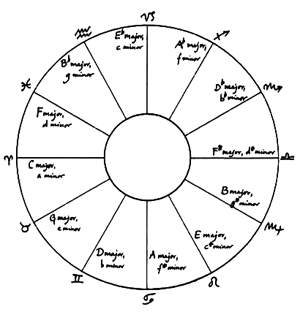
(image: Godwin 1987, 147)
The Anthroposophical Tone-Zodiac, based on the ideas of Rudolf Steiner (the founder of Antroposophy) does not only connected the star signs with the major and minor keys, but represented the twelve creative figurations of the Archangels, the Seraphim and Cherubim, so that each tone existed as sound and as inner experience on the Etheric and Astral levels.
“All spiritual experience resulted from the awareness that the number of planets was contained in the seven scales, and the number of signs in the Zodiac was contained in the twelve fifths within the seven scales. The great mystery of man was revealed in the Circle of Fifths.” (Rudolf Steiner)
This Tone-Zodiac has the following Tone-Sign combination:
| C | G | D | A | E | B | F♯ G♭ |
D♭ | A♭ | E♭ | B♭ | F |
| Am | Em | Bm | F♯m | C♯m | G♯m | D♯m E♭m |
B♭m | Fm | Cm | Gm | Dm |
Rudolf Steiner’s Tone-Zodiac starts at Aries with C (and A minor) and goes around the Circle of Fifths counterclockwise (as is common with Astrology).
MAX HEINDEL (1865-1919)
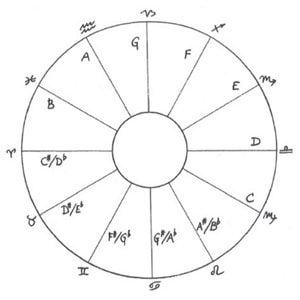
(image: Godwin)
Max Heindel (born Carl Louis von Grasshoff) was a Danish-American Christian occultist, astrologer, mystic and Rosicrucian Institute.
Max Heindel and Rudolf Steiner met in 1907 in Berlin and Heindel sat-in on several lectures of Steiner and spoke with him several times. Heindel did develop his own teachings Western Wisdom Teachings, very different from that of Steiner.
This Tone-Zodiac has the following Tone-Sign combination:
| C♯/D♭ | D♯/E♭ | F♯/G♭ | G♯/A♭ | A♯/B♭ | C | D | E | F | G/A | A | B |
His Tone-Zodiac starts at Aries with C♯ and goes counterclockwise around the Zodiac Circle.
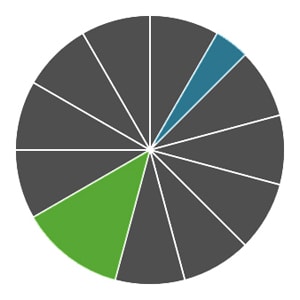
There is though an “odd thing” going on with this Tone-Zodiac. Most sections of this Zodiac covers 2 semitones per 30°. But, the section that belongs to Taurus (from D♯/E♭ to F♯/G♭) covers 3 semitones and the section that belongs to Scorpio(from E to F) only covers 1 semitone.
This means that the drawing of Max Heindel’s Tone Zodiac is incorrect. In the image on the left you can see how the Tone-Zodiac should have been divided based on the number of semitones as based on the noted tones.
If you analyze the tones used, we can form two Hexatonic (whole tone) scales with it:
Gb-Ab-Bb-C-D-E and F-G-A-B-C#-D#. Is that what Max Heindel had in mind?
The “problem” with the Hexatonic scale is that it closes a circle in 6 steps, not in 12 steps, as with the Chromatic Circle and the Circle of Fifths. This could explain why two of the sections (Taurus and Scorpio) are different in size, to be able to “close the circe” with two Hexatonic scales in the same circle. This is though a “fix” that is not logical or correct not from a musical standpoint, nor from a mathematical or geometric point of view. The circle (when drawn with sections equal in size to the intervals between the tones) does not look very “aesthetic” (something common for Taurus), the largest section in the circle.
Depending on the source the Taurus-Scorpio axis could represent one of various things such as: desires (in the sense of ownership, possession), the intensification and stabilization of the self and its environment, “Axis of True Being” (the confrontation of the self with its shadow), et cetera. Perhaps the axis of Taurus and Scorpio had special meaning to Max Heindel and that is why he chose to start the Hexatonic scales from these two signs?
There is only one “right way” to use Hexatonic scales as basis for a tone circle though. You can only use the Hexatonic scales as basis for a mathematically and musically correct tone circle if you use a tone circle with two concentric rings. Saxophonist John Coltrane drew the only functioning Hexatonic Tone Circle in existence. You can read more about that in the article “The Coltrane Tone Circle“.
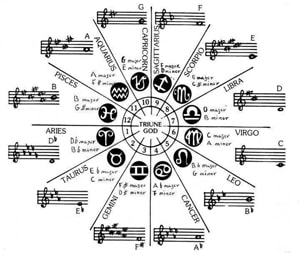
MAX HEINDEL TONE-ZODIAC “REPRODUCTION”
This Tone Zodiac image is one of the most shared Tone Zodiacs on the internet. I had difficulties finding out who made it (and I still don’t know), but when I analyzed this Tone-Zodiac I recognized the discrepancies in the tone-spacing.
This Tone-Zodiac is a “reproduction” of the Tone-Zodiac made by Max Heindel shown above.
ANNY VON LANGE (1887-1959)
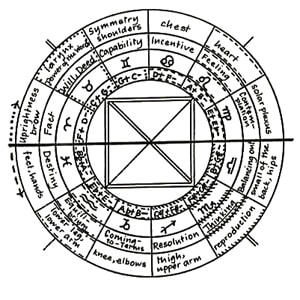
Rudolf Steiner’s Student Anny von Lange worked her ideas out for her book “Man, Music and Cosmos” (1956).
On her tone-zodiac she writes: “Twelve heavenly spheres are portals for the incoming cosmic forming forces which work upon man, each in its own appointed way.” (von Lange 1992, p. 309)
This Tone-Zodiac has the following Tone-Sign combination:
| F | C | G | D | A | E | B | F♯ | C♯ | A♭ | E♭ | B♭ |
| Dm | Gm | Cm | Fm | B♭m | E♭m | G♯m | C♯m | F♯m | Bm | Em | Am |
Anny von Lange’s Tone-Zodiac starts at Aries with F (and D minor) and goes around the Circle of Fifths clockwise (as is common in music with the Circle of Fifths). It is important to note that the minor tonalities listed at von Lange’s Tone-Zodiac are NOT the minor relative tonalities of the listed Major tonalities! The tonic of the minor tonalities are a descending Fourth apart from the tonic of the Major tonalities, instead of a descending minor Third.
SIGISMUND VON GLEICH (1896-1953)

In the book “Über die Wirkung der Tonarten in der Musik “(About the Effect of Tonalities in Music)” by Sigismund von Gleich we find a rather original drawing of the Tone-Zodiac, in the shape of a lemniscate.
This concept is based on the idea that there is a “mirror-relationship” between the Major and minor tonalities.
The 12 tones are divided into two groups, a group of connected Major tonalities (C-G-D-A-E-B) directed outwards going “up-around-and-down” the left part of the lemniscate, followed by a group of connected Major tonalities (Gb-Db-Ab-Eb-Bb-F) directed inwards going “down-around-and-up” the right part of the lemniscate. The minor tonalities follow the same movement in opposite direction. You could say that the Major and minor tonalities “mirror” each others movement. Libra – the only tonality with an equal number of sharps (#) and flats (♭) is located at the crossing between both sides of the lemniscate.
Within this Tone-Zodiac design you can see a Lenmiscate Ouroboros, (the tail-devouring snake).
This Tone Zodiac Lemniscate has the following Tone-Sign combination:
| C | G | D | A | E | B | F♯ G♭ |
D♭ | A♭ | E♭ | B♭ | F |
| Am | Em | Bm | F♯m | C♯m | G♯m | D♯m E♭m |
B♭m | Fm | Cm | Gm | Dm |
This Tone Zodiac follows the Circle of Fifths and starts with Aries at C Major (on the left) and A minor (on the right) of the lemniscate and goes around in both clockwise and counterclockwise movements.
This Tone-Sign combination is the same as Rudolf Steiner’s.
MARIUS SCHNEIDER (1903-1982)
TONE ZODIAC
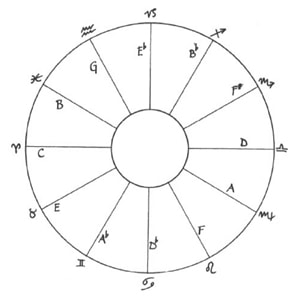
SOLAR-LUNAR TONE ZODIAC
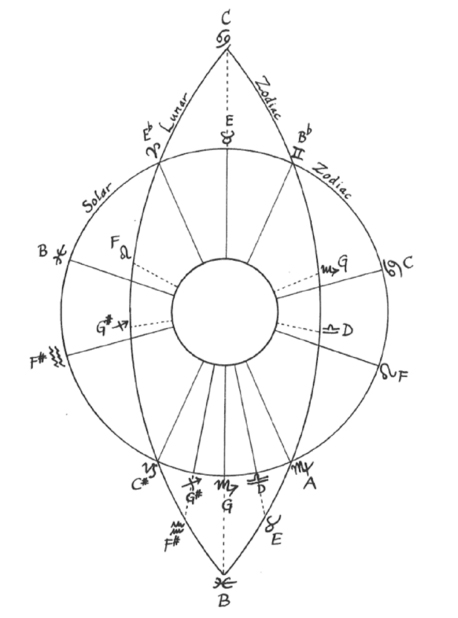
TONE ZODIAC SPIRAL
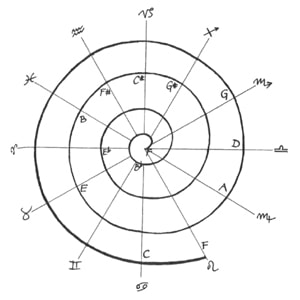
Marius Schneider was a musicologist who created an entirely original system that traces its origin to the world-wide spiritual culture of the Megalithic era (Godwin 1987, p. 149). His work is full of tone-zodiacs, some very creative and original, when looking at the Tone-Zodiacs by Marius Schneider it is obvious we are looking at the work of a unique individual.
SCHNEIDER’S TONE ZODIAC
(1st Zodiac above)
This Tone-Zodiac starts at Aries on C and go around the circle counterclockwise. The intervals between the tones differ though.
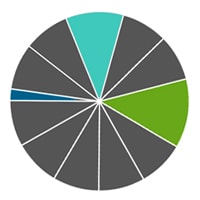
Most of the sections cover Major Thirds (4 semitones) except for Virgo (from A♭ to D) covering 6 semitones, Sagittarius (from B♭ to E♭) covering 5 semitones and Pisces (from B to C) – covering 1 semitone.
This means that the drawing of Marius Schneiders’ Tone Zodiac (as provided by Godwin) isn’t mathematically drawn correct. In the image on the right you can see how the Tone-Zodiac should have been divided based on the number of semitones as based on the noted tones.
|
This Tone-Zodiac has the following Tone-Sign combination: 
|
|||||||||||
|
C |
E |
A♭ |
D♭ |
F |
A |
D |
F♯ |
B♭ |
E♭ |
G |
B |
This Tone-Zodiac is probably the most “complicated” in design that I have come across. It combines a “Solar Zodiac” (circle) and what Schneider called a “Lunar Zodiac” (ellipse).
The intervals between the tones placed on the Tone Zodiacs and the size of the “sectors” do not match and that means that the drawing of Marius Schneiders Solar-Lunar Tone Zodiac (as provided by Godwin) is mathematically incorrect. To make a Tone-Zodiac for this concept that is mathematically drawn correct and still “pretty-looking” is probably out of the question.
But, we can appreciate it for it’s creative design, originality and the astrological idea behind it!
|
This Tone-Zodiac has the following Tone-Sign combination: 
|
|||||||||||
|
E♭ |
E |
B♭ |
C |
F |
A |
D |
G |
G♯ |
C♯ |
F♯ |
B |
TONE ZODIAC SPIRAL
(3rd Zodiac above)
That Schneider was a creative thinker becomes very clear with the “Tone-Spiral” – called the “Form of Cosmic Evolution” – the 12 tones are placed on a Spiral according to the astrological quadruplicities.
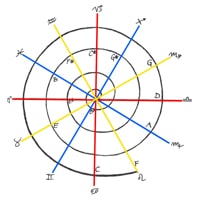
Within this sign-group the Zodiac Signs are divided in 3 Modes. The Signs from the same Mode form a Square or a Cross.These Modes are: CARDINAL (Aries, Cancer, Libra and Capricorn), FIXED (Taurus, Leo, Scorpio and Aquarius) and MUTABLE (Gemini, Virgo, Sagittarius and Pisces).
|
This Tone-Zodiac has the following Tone-Sign combination: 
|
|||||||||||
| Eb | E | Bb | C | F | A | D | G | G# | C# | F# | B |
Later in this article you will find more information about the “Zodiac sign-groups” and an example with squares.
ALAIN DANIÉLOU (1907-1994)
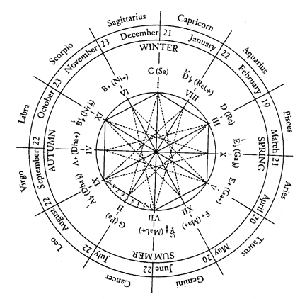
This Tone Zodiac shows the correspondences of the 12 tones with the Zodiac signs, months and seasons. The names for the notes are in Indian, though the Tone Zodiac is ancient Chinese (from the book “Music and the Power of Sound” by Alain Daniélou).
The order of succession of the Fifths is pointed-out by the points of the dodecagram (12-point star) and numbered I-XII (Roman numerals). Each tone is connected by a dotted lines to its upper Fifth and its lower Fifth.
The notes that correspond to the angles of the hexagon are masculine (C–D–E–F#–Ab–Bb), the notes that correspond to the middle of the sides are feminine (Db–Eb–F–G–A–B), forming two Hexatonic or Whole-Tone scales.
|
This Tone-Zodiac has the following Tone-Sign combination: 
|
|||||||||||
|
E♭ |
E |
F |
F♯ |
G |
A♭ |
A |
B♭ |
B |
C |
D♭ |
E |
This Tone-Zodiac is uses the Chromatic circle and goes round clockwise. C relates to Capricorn as Aries (the Western starting point) relates to Eb.
STOCKHAUSEN (1928-2007)
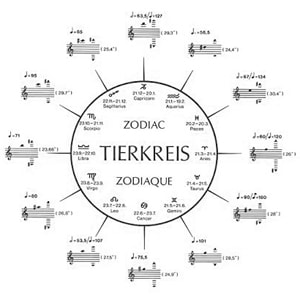
1975 – German composer Karlheinz Stockhausen wrote a musical composition in 1975 called “Tierkreis” (Zodiac in German). Stockhausen was a student of Schönberg, abandoning the seven uneven steps of the major scale to the twelve equal notes of dodecaphony and serialism.
The Tierkreis melodies are constructed on several series that rule pitch and duration. The “zentraltöne” of the melodies form a chromatic scale. The tempos of melodies are ordered like a chromatic scale.
|
This Tone-Zodiac has the following Tone-Sign combination: 
|
|||||||||||
|
F |
F♯ |
G |
G♯ |
A |
A♯ |
B |
C |
C♯ |
D |
D♯ |
E |
Karlheinz Stockhausen used the Chromatic Circle, starting at Aries with F, following the circle clockwise (as is common in music with tone circles) in semitone-steps.
HENSCHEL & HENSCHEL-FISHER
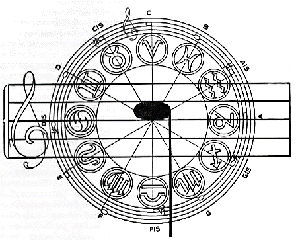
1954 – Tone-Zodiac by Joan Henschel and Mary Henschel-Fischer (musicologist). They see their own times as chaotic and urge change, expecting the Age of Aquarius to bring about the joining of music, mathematics and astrology in the true universal religion.
Joscelyn Godwin has pointed out their “poor astrology” and “dubious musical results“, such as calling the perfect fifth and fourth “dissonant” intervals (source: Godwin 1987, p. 142).
|
This Tone-Zodiac has the following Tone-Sign combination: 
|
|||||||||||
| C | C♯ | D | D♯ | E | F | F♯ | G | G♯ | A | A♯ | B |
The Henschels use the Chromatic Circle, starting at Aries with “C”, following the circle counterclock-wise (as is common in Astrology) in semitone-steps.
MCMULLIN
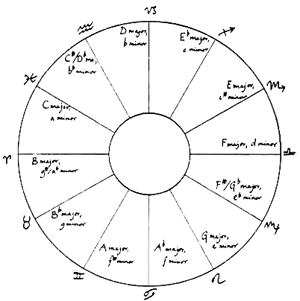
(image: Godwin)
The Irish astrologer and musicologist Michael McMullin sees Carl Jung as one of the great teachers of our age. His Tone-Zodiac dates from (1984).
“One can say that the voice of God has come to the West not through organized religion but through music, and that music’s great ‘bodhisattvas’, or avatars have been the messengers of a higher reality.” (McMullin 2006)
|
This Tone-Zodiac has the following Tone-Sign combination: 
|
|||||||||||
| B | B♭ | A | A♭ | G | F♯/G♭ | F | E | E♭ | D | C♯/D♭ | C |
| G♯m/A♭ | Gm | F♯m | Fm | Cm | E♭m | Dm | C♯m | Cm | Bm | B♭m | Am |
Michael McMullin used the Chromatic Circle, starting at Aries with B, following the circle counterclockwise in semitone-steps down the chromatic scale.
ASTROLOGICAL ASPECTS, SIGN-GROUPS, MODES AND DEGREES
“Opposition“, “Trine” and “Square” are commonly used terms by astrologers to define important relative positions of planets. Every aspect relates to a particular number of degrees. Opposition = 180°, the Trine = 120° and the Square = 90°. More information about some of these “Zodiac sign-groups” will follow later in this article. For now I will focus on the degrees and how they relate to the Tone-Zodiac.
Kepler is said to have been impressed – as Ptolemy before him – by the fact that these three most powerful aspects are expressed by the same ratios as the three perfect consonances in music.
| ASPECT | DEGREES | RATIO CIRCLE | RATIO INTERVAL |
| 180° | 360:180 = whole circle to half | 2:1 = Octave | |
| 120° | 360:240 = whole to greater part | 3:2 = Perfect Fifth | |
| 90° | 360:270 = whole to greater part | 4:3 = Perfect Fourth |
JOHANNES KEPLER (1571-1630)
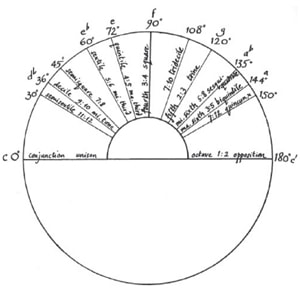
In his Tone-Zodiac (image: Godwin) Johannes Kepler places the Unison (Tonic) and Octave across (opposite) each other with all aspects in between, as if the Zodiac represented a hypothetical monochord string, in other words a logarithmic scale. The musicians among the readers of this article will undoubtedly frown looking at it, as did Rudolf Haase (see below).
Even though quantitatively perfect, it still did not match the astrological qualities with the qualities of the intervals. The most obvious example is the “opposition“, one of the more tension-producing (disharmonious) aspects in Astrology. The great challenge of the opposition is to integrate the two poles. At Kepler’s Tone-Zodiac the Unison and the Octave have been placed in opposition with each other.
The distance (interval) between the Unison and Octave in music though, is the most consonant (tension-free or “harmonious“) of all intervals. They are so harmonious, that when you play them together, it becomes very difficult to separate them from each other. They instantaneously “become one” to the listener.
What we see in Kepler’s Tone-Zodiac, is the incompatibility of musical and astronomical distances, the incomparability between the logarithmic scale of the monochord (on which equal divisions produce increasing intervals) with the geometry of a circle divided into 360 equal degrees.
The astrological website www.astro.com offers a free “Sound Horoscope” based on Kepler’s concept. Personally I would not recommend using this “Sound Horoscope”. If they – like Kepler – use the Unison and Octave (most harmonious interval, tension-free) as “opposition” (much tension), then they obviously do not know much about sound and music theory!
Personal footnote: At first I was thrilled when I came across Kepler’s concept, I thought “I stroke gold” and had found the answers I had been looking for. But when comparing the functions of the intervals and their particularities to the aspects related to the degrees, I was a bit disappointed, they didn’t truly match. Not much later I saw I had not been the only person that felt that way, Rudolf Haase has done so way before me. Rudolf Haase thus suggested an alternative scheme for the degree-based Tone-Zodiac:
RUDOLF HAASE (1920–2013)
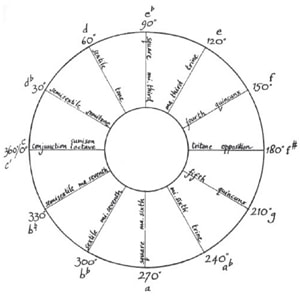
German musicologist Rudolf Haase aligned the placement of the 12 tones with the standard division of the Zodiac circle, where each sector of the circle is 30°, much alike 12-Tone Equal Temperament, that is represented by a circle of 1200 cents, divided into 12 Equal sectors of 100 cents per semitone.
The opposition is now the dissonant Tritone while the Unison and Octave coincide. The Major Third (an interval with an “optimistic” character) aligns with the (positive) Trine (120°) while the Minor Third (an interval with a somewhat “pessimistic” character) aligns with the (negative) Square(90°). Haase also mentions that in modern times even the semitone and Major Seventh are treated as consonant just as their aspects the Sextile (60°) and Semi-Sextile (30°).
Not all aspects can be used in this circle The “Decile” (36°), “Semisquare” (45°), “Quintile” (72°), “Tridecile” (108°), “Sesquiquartile” (135°) and Biquintile (144°) are not part of the scheme.
You might also have noticed that no Zodiac Signs have been drawn into this Tone-Zodiac. The focus point of this scheme is not the Tones, but the Intervals, as it is with the “Movable Do” system. This scheme can be used for every tonality.
SUMMERY HISTORICAL TIME-LINE
After reading some books, lectures and online articles and “studying” various Tone-Zodiacs, I noticed that the Circles (Scales) and tonalities used differs a lot as you can see in this summery:
|
KEY→ |
C | C♯ D♭ |
D | D♯ E♭ |
E | F | F♯ G♭ |
G | G♯ A♭ |
A | A♯ B♭ |
B |
| CC | 1 | 1 | 1 | 1 | ||||||||
| C.O.F | 2 | 1 | ||||||||||
| VARIOUS | 2 | 2 | 1 | 2 | 1 | 4 |
This means that looking into the past did not give us an unambiguous answer to the question: “What tonality relates to what Zodiac Sign”?
Later in this article I will share my own view on it. I will first proceed with some additional information about Astrological Modes and the Zodiac Signs & Colors.
GEOMETRY & GROUPS: POLARITIES, TRIPLICITIES, QUADRUPLICITIES & DUALITIES
I mentioned “grouping” of the Zodiac Signs during the historical time-line. So what are those “groups”?
| POLARITIES (opposition – 180°) |
TRIPLICITIES (trine – 120°) |
QUADRUPLICITIES (square – 90°) |
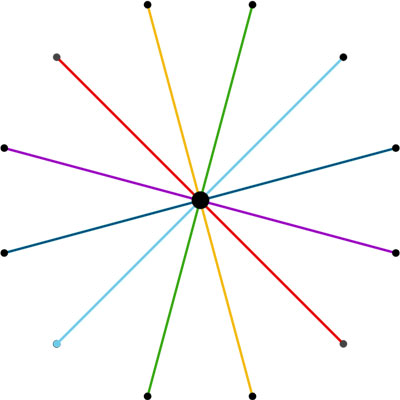 |
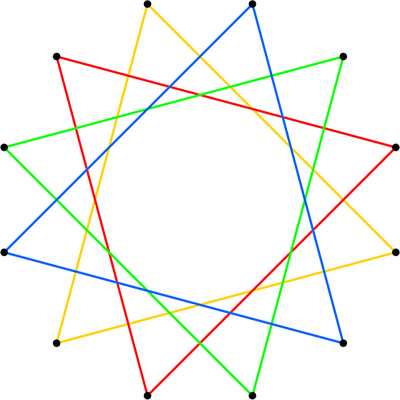 |
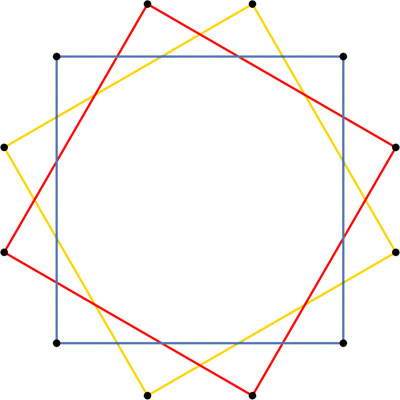 |
NOTE: the colors used in these examples are just to differentiate between the sign-groups based on the mode-division. The proper tone-color combination can be found later in this article!
CIRCLE OF FIFTHS & THE ZODIAC CIRCLE and their SHAPES, DEGREES, INTERVALS:
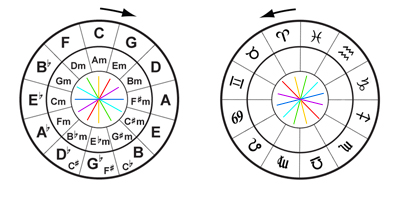
LINE: POLARITIES
![]() Opposition (180°), 6{2}
Opposition (180°), 6{2}
The opposition causes exaggeration as it is not unifying.
The “connected” (opposite) tones in the Circle of Fifths are a “Tritone“ apart from one another: C-G♭, G-D♭, D-A♭, A-E♭, E-B♭ & B-F.
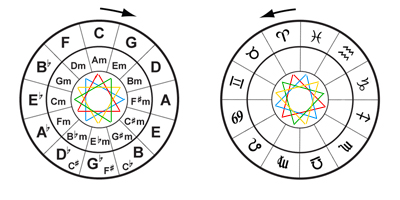
TRIGON: TRIPLICITIES (THE 4 ELEMENTS)![]() Trine (120°), 4{3}
Trine (120°), 4{3}
The trigon, triangle or trine indicates harmony and ease.
![]() FIRE: Aries, Leo and Sagittarius
FIRE: Aries, Leo and Sagittarius![]() EARTH: Taurus, Virgo and Capricorn
EARTH: Taurus, Virgo and Capricorn![]() AIR: Gemini, Libra and Aquarius
AIR: Gemini, Libra and Aquarius![]() WATER: Cancer, Scorpio and Pisces
WATER: Cancer, Scorpio and Pisces
The clockwise “connected” tones in the Circle of Fifths are a Major Third apart from one another:
C-E, E-A♭ & A♭-C / G-B, B-E♭ & E♭-G D-G♭, G♭-B♭ B♭-D / A-D♭, D♭-F F-A. Counterclockwise the “connected” tones in the Circle of Fifths are a Minor Sixth apart.
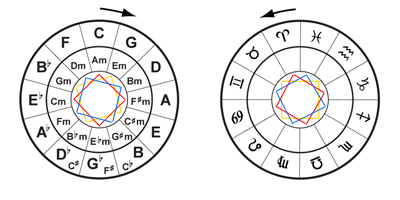
SQUARE: QUADRUPLICITIES (THE MODES)![]() Square (90°), 3{4}
Square (90°), 3{4}
![]() CARDINAL: Aries, Cancer, Libra and Capricorn
CARDINAL: Aries, Cancer, Libra and Capricorn![]() FIXED: Taurus, Leo, Scorpio and Aquarius
FIXED: Taurus, Leo, Scorpio and Aquarius![]() MUTABLE: Gemini, Virgo, Sagittarius and Pisces
MUTABLE: Gemini, Virgo, Sagittarius and Pisces
The counterclockwise “connected” tones in the Circle of Fifths are a Minor Third apart from one another: C-E♭, E♭-G♭, G♭-A & A-C / B♭-D♭, D♭-E, G-B♭ / F-A♭, A♭-B, B-D & D-F. Clockwise the “connected” tones in the Circle of Fifths are a Major Sixth apart.
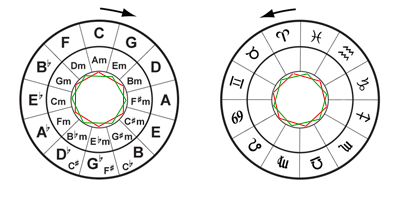
HEXAGON: DUALITIES (♂ & ♀)
![]() Sextile (60°), 2{6}
Sextile (60°), 2{6}
Representing “masculine and feminine” or “positive and negative” (+ & –).
The Sextile represents “ease of communication” between the elements involved, with compatibility and harmony between them. The Zodiac signs can be divided into two groups of 6 signs:
MASCULINE SIGNS: Fire + Air signs
FEMININE SIGNS: Earth + Water signs
The “connected” signs form two Hexatonic or Whole Tone Scales when combined: C–D–E–F♯–G♯–A♯–C and G–A–B–D♭–E♭–F–G. The tone distances up the scale, represent the Whole Tones. Naturally going down a whole tone (Major Second) is “equal to” going up the Scale a Minor Seventh (10 Semitones). The Hexagon thus represents both the Major Second (Whole Tone) and Minor Seventh.
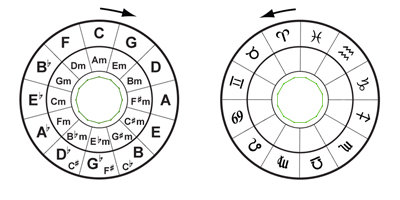
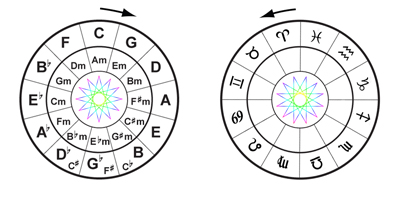
DODECAGRAM ![]() Quincunx (150°), t{6/5}={12/5}
Quincunx (150°), t{6/5}={12/5}
The Dodecagram is – like the Dodecagon – not one of the traditional 3 “groups” but does represent an aspect called the “Quincunx“.
When you follow the lines of the Dodecagram across, you “traverse” chromatically up or down the Chromatic Scale. Naturally going a Minor Second (semitone) down the Chromatic Scale is “equal to” going a Major Seventh (11 semitones) up the scale. The Dodecagram thus represents both the Minor Second (Semitone) and the Major Seventh.
OTHER ASPECTS
The “Decile” (36°), “Semisquare” (45°), “Quintile” (72°), “Tridecile” (108°), “Sesquiquartile” (135°) and Biquintile (144°) are not part of this scheme. These aspects fall in between the intervals we use in the 12-Tone (Equal Tempered) musical tuning.
Below all aspects that relate to musical intervals used:
| LINE | TRIGON | SQUARE | HEXAGON | DODECAGON | DODECAGRAM | |
 |
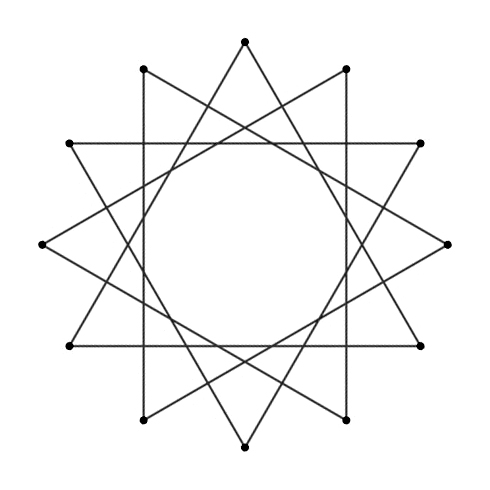 |
 |
 |
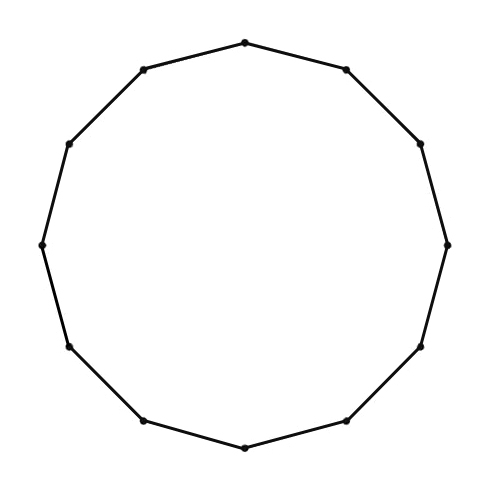 |
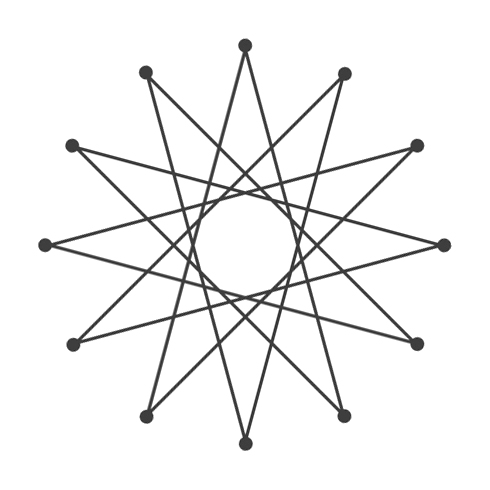 |
|
| 6{2} | 4{3} | 3{4} | 2{6} | t{6} | t{6/5}={12/5} | |
| C C |
TRITONES | MAJOR THIRDS |
MINOR THIRDS |
MAJOR SECOND |
MINOR SECOND MAJOR SEVENTH |
FIFTHS FOURTHS |
| C o F |
MINOR SIXTHS | MAJOR SIXTHS | MINOR SEVENTH | FIFTHS FOURTHS |
MINOR SECOND MAJOR SEVENTH |
|
| Opposition | Trine | Square | Sextile | Semi-Sextile | Quincunx | |
| 180° | 120° | 90° | 60° | 30° | 150° | |
|
“POLARITIES“
|
“TRIPLICITIES“
|
“QUADRUPLICITIES“
|
“DUALITIES“
|
The degrees listed above relate to the angles of 2 dots relatively to each other from the center point of the geometric shapes. With these geometric “shapes” combined, all possible tone-connections can be made, as is clear from the superimposed graph. Naturally this counts only for 12-Tone systems.
CHROMATIC CIRLCE
If you use the Chromatic Circle instead of the Circle of Fifths (as used for the examples above), then the sign-groups (Polarities, Triplicities and Quadruplicities) and the Hexagon align with the Signs and Tones in a similar manner as they do with the Circle of Fifths.
There is one difference though. With the Circle of Fifths the Dodecagon connects the Fifths/Fourths and the Dodecagram visualizes the Chromatic Scale, but if the Chromatic Circle is used, the Dodecagon would visualize the Chromatic Scale and the Dodecagram would connect the Fifths/Fourths instead.
OTHER MUSICAL INTERVAL SYSTEMS
Not all Musical Interval Systems contain 12 tones. With a different number of tones different geometric “shapes” need to be used. Some of the Tone-Zodiacs presented earlier in this article (like those by Ptolemy) use for example only 7 tones (Greek modes). For Tone-Zodiacs using 7 tones or scale degrees you could use the Heptagram and Heptagon.
THE CHROMATIC SCALE, THE PIANO AND THE MONTHS OF THE YEAR
There is yet another way to connect keys / tonalities with Zodiac signs. The Western tone system has 12 tones, as there are 12 Zodiac signs and 12 months. The 12 months do not contain the same numbers of days. There are 7 months with 31 days, and 5 months with less (30 or 28/29), as there are 7 white keys and 5 black keys.
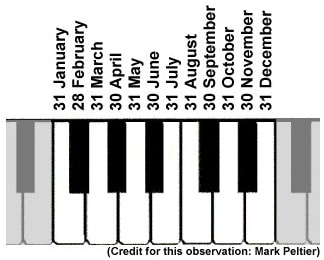
If we examine the following order of keys of the piano (and the Chromatic Scale), then there are 2 places where on the piano two white keys are next to each other, between B and C and E and F.
Much alike the division of the months, December and January and July and August are the only two moments in the year that 31-day (white key) months follow each other directly.
Even more interesting is that both piano keys and months follow the same pattern:
Starting from January 31:less = White:Black = 7:5 = 4:3 + 3:2
Starting from tone C White:Black = 31:less = 7:5 = 3:2 + 4:3
There is though one thing to keep in mind … the Zodiac Signs do not align with the months of our calendar. Each sign starts and ends around the 20th (18-23th) of each month. There are thus 2 variants possible.
The first variation aligns to key / tonality with the start of the Zodiac signs (Decan 1) and is as shown in the image above (by Mark Peltier). The second variation aligns with the a sign with the largest coverage of a month (Decans 2 & 3).
Every Zodiac Sign covers 30 Degrees of the Zodiac Circle. Every Zodiac Sign is divided in 3 Decans, each of 10 degrees. It is said that the 1st Decan (0-9 degrees) corresponds to the physical side and relates to the body, the 2nd Decan (10-19 degrees) corresponds to the mental or the Mind side and the 3rd Decan (20-29 degrees) corresponds to the spiritual aspects of a person. Astrologers could base this decision also on the actual position of the planets within the Zodiac Sign’s Decans.
|
VARIANT1 – STARTING WITH ARIES (THE FIRST SIGN):
|
|||||||||||
|
G |
G♯ |
A |
A♯ |
B |
C |
C♯ |
D |
D♯ |
E |
F |
F♯ |
|
Mar. |
Apr. |
May |
Jun. |
Jul. |
Aug. |
Sep. |
Oct. |
Nov. |
Dec. |
Jan. |
Feb. |
|
VARIANT 2 – STARTING WITH ARIES (THE FIRST SIGN):
|
|||||||||||
|
F♯ |
G |
G♯ |
A |
A♯ |
B |
C |
C♯ |
D |
D♯ |
E |
F |
|
Apr. |
May |
Jun. |
Jul. |
Aug. |
Sep. |
Oct. |
Nov. |
Dec. |
Jan. |
Feb. |
Mar. |
What variant should you use? Well, that’s up to you to decide.
Alternatively, for those who do not read astrological charts a choice for each variant could very well depend on the type of music you are making. I would suggest using variant 1 for music related to dance and other physical expressions of music and variant 2 for listening and meditative purposes.
MUSIC & GEOMETRY
If you are interested in more information about the geometry in music then read the article “Music & Geometry“.
! ROEL’S WORLD INTERPRETATION & IMPLEMENTATION !
With some concepts (such as Kepler’s Tone Zodiac) the astrological, astronomical and/or mathematical values have been the starting point to build a Tone Zodiac. This sometimes mend that music came ‘second’ in order to make a concept work. Important to me though is to be sure the functions of the intervals, the meaning of tones, scales and tonalities are preserved and not “re-interpreted” to prove an otherwise mathematical correct concept with.
In the article “The Astrological Zodiac & Musical Tonality – Roel’s Interpretation” I wrote in more detail about the tone-sign combination that I think is the most cogent.
WORKS BY MUSICIANS, COMPOSERS & PRODUCERS
Various composers and musicians have been inspired by the Zodiac signs. Note that not all of them listed below followed a concrete Tone-Zodiac. Some of these care:
Nat Adderley (“Soul Zodiac“), Cannonball Adderley (‘Love, Sex and the Zodiac‘), John Coltrane (“Interstellar Space“), Mary Lou Williams (“Zodiac Suite“), Marion Brown (“Capricorn Moon“), Mort Garson (“The Zodiac – Cosmic Sounds“), Dick Jacobs & Rod McKuen (“Written in the Stars“), Nathan Hall (“Earth, Sea, Sky“), Aleksandar Simić (“Zodiac“), Barry Cockcroft (“Zodiac – 12 pieces“), Bright Sheng (“Zodiac Tales – Concerto for Orchestra“), Key Poulan (“Zodiac“), Charles Matthews (“Signs of the Zodiac – Study method for Flute and Piano“) and others.








I also came across a series of albums by “Zodiac Tribe“. The music on these albums is “Ambient”, for “meditative and visualization”. You can listen to it on Spotify, Deezer and other online stream services and online stores. ! NOTE: The creator(s) of “Music Of The Zodiac” did not pay much attention to the tonality and Zodiac sign relationships! Perhaps this is because of their choice of instruments, some “ethnic” instruments used (like a flute) might not be able to play in all 12 tonalities.

Each episode is specific to a music key and a vocal narration by Pietropaolo discusses the personality traits of that key, with accompanying music written in that key, taken from music written over the centuries. In 2013, Pietropaolo won the Prix Italia in the category of best work for music for the program. Listen on Soundcloud!
RELATED ARTICLES:
THE ASTROLOGICAL ZODIAC & MUSIC TONALITY – ROEL’S INTERPRETATION
This is an addition to this article, with Roel’s personal interpretation of “The Astrological Zodiac & Music Tonality“.
ASTRO-MUSIC COMPOSITION
This is an article with some ideas about how to create a “tone-collection” based on your astrological (birth) chart that can be used for composing music: “Astro-Music Composition (chart to music)“.
THE ASTRONOMICAL ZODIAC SCALE
If you like my article about the Astrological Zodiac & Tonality and you are interested in Micro-tonal music, then you might also like the article “The Astronomical Zodiac Scale (Temperament)“.
THE FUNCTIONS OF THE INTERVALS
Another article I wrote for my blog named “The Functions Of The Intervals” (referred to in this article) describes might be an interesting read as well?
AND NOW … TO CONCLUDE THIS ARTICLE WITH:
A youtube playlist with a collection of Zodiac music by some of the artists mentioned earlier in this article:
CREDITS
For the historical “time-line” about the Tone Zodiacs I have quoted Eduard Heyning from his essay “The Tone-Zodiac Symbol“. I did make a few changes and added some footnotes. If you like that part of this blog article, then you might like his essay about the Tone Zodiacs (and more) on academia.edu as well, or visit www.tierkreis.nu (about Stockhausen).
The images used are mostly copies from “Harmonies of Heaven and Earth: Mysticism in Music from Antiquity to the Avant-Garde” by Joscelyn Godwin, completed with images from the work of Sigismund von Gleich, Alain Daniélou, Karlheinz Stockhausen and Henschel. I have modified several tone-circle images that were shared online and added a few of my own.
OTHER SOURCES / REFERENCES:
- “Harmonies of Heaven and Earth: Mysticism in Music from Antiquity to the Avant-Garde” (by Joscelyn Godwin)
- “Über die Wirkung der Tonarten in der Musik” (by Sigismund von Gleich)
- “Writings on Music” (by John Wallis)
- “Mensch, Musik und Kosmos” (by Anny von Lange)
- www.tonalsoft.com – Encyclopedia of Microtonal Music Theory
- www.flutopedia.com – Color of Sound calculator
- http://wiki.astro.com/astrowiki/ (AstroWiki)
- http://en.wikipedia.org/wiki/Zodiac (Wikipedia)
- http://en.wikipedia.org/wiki/Seasons (Wikipedia)
- http://en.wikipedia.org/wiki/Planets_in_astrology (Wikipedia)
- http://en.wikipedia.org/wiki/Tierkreis_(Stockhausen) (Wikipedia)

